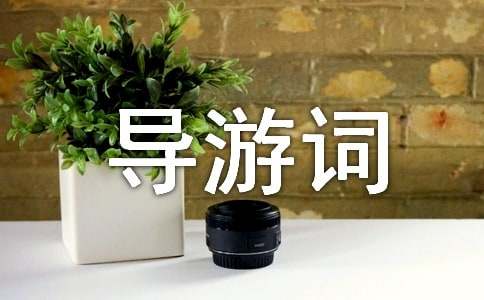明十三陵景点中英双语导游词
景点讲解题

题一:明十三陵概况及神道(历史沿革;今日十三陵;石牌坊;大红门;长陵神功圣德碑;石像生;棂星门)
题二:明十三陵概况及长陵(历史沿革;今日十三陵;明成祖朱棣;长陵布局;长陵祾恩殿;人殉制度)
题三:定陵(明神宗朱翊钧;朱翊钧的皇后;定陵考古发掘的过程;定陵地宫布局及陈设;金井;定陵出土文物)
讲解提示
明十三陵的'环境不复杂,但内容丰富。第一题讲解内容可从概况开始,经牌楼到神路为一部分。这部分内容有线路可供遵循,顺序讲解即可。第二题注意概况的内容和长陵的衔接。第三题讲解内容以定陵为主,讲解顺序应以教材章节为参考。
第二部 模拟讲解词
英文范例
题一:明十三陵概况及神道
Good morning ladies and gentlemen, today we are going to pay a visit to the Thirteen Ming Tombs. First, I will give you a brief introduction of it. The Ming Tombs are located in Changping District, about 50 kilometers on the northwest of Beijing. This imperial cemetery covers an area of 40 square kilometers with 13 Ming emperors,23 empresses, many imperial concubines, princes and princesses buried there. These tombs are the best-preserved of all Chinese imperial tombs. The Ming Dynasty started from 1368 to 1644, lasting 276 years. Altogether 16 emperors ruled in the Ming Dynasty. But out of the 16 emperors, 13 emperors were buried in Beijing Ming Dynasty Tombs area. The first Ming Emperor Zhu Yuanzhang was buried in Xiaoling of Nanjing. The second emperor had no tomb. The seventh emperor Jing Tai was buried at Jinshan Mountain in the western suburbs of Beijing.
The Sacred Way, that we visit now, was originally designed for the Changling Tomb. The sacred way to other tombs originally from this one, it became the general sacred way for all. Along the 7.3kilometers long sacred way stands the Marble Archway, the Big Rad Gate, Tablet Tower, Stone Statues and Dragon and Phoenix Gate. Now let's take a look from the southern end.
Firstly let's look at the Marble Archway. The Marble Archway was built in 1540 during the reign of Emperor Jiajing in the Ming Dynasty for promoting the meritorious and virtuous deeds of the feudal rulers, but still in an excellent condition. It is 14 meters high and 29 meters wide and it has 5 arches supported by 6 marble pillars with beautiful carvings of dragons, lions, lotus flowers and clouds. It is the earliest and best-preserved stone archway still existing in China.
500 meters to the north of the Stone Archway stands the main gate of the mausoleum, called the Big Red Gate. The gate has three passageways: the central passageway was for the deceased emperor only, the living emperor and this ministers as well as the imperial family members had to use the side openings when they came to pay their homage to their ancestors. And nobody could enter the gate on horseback for there are two stone tablets placed on either side of the gate, inscribed with the words:“ Officials and others should sidmount from their horseback”。 Those who violated the rule would be punished for disrespect.
Passing the cypress trees, lies the double-eaces Stele Pavilion, or the Stele Pavilion of Divine Merit and Sacred Virtue. Inside the tower there is a huge tablet, 7.9 meters high, which stands on the back of a giant stone tortoise in the middle of the Tablet Tower. On the table inscribed with the words: “Tablet of Diving Merits and Sagely Virtue of Chang Ling of the Great Ming.”
Not far from the Stele Pavilion there are 18 pairs of stone sculptures and beasts along the Sacred Way. The custom to put up stone sculptures in front of the imperial cemeteries started as early as the Qin and Han dynasties in Chinese history. It shows the supreme authority and dignity of the emperors and served as ceremonial guards. The Stone Statues along the Sacred Way are totally 36 altogether, with 24 stone animals and 12 stone human figures. They are 6 kinds of animals, 4 in each group. The first group of animals is 4 lions arranged in the front, followed by Xiezhi , camels, elephants, Qilin unicorns and horsrs. In ancient time, lions symbolized forzce, Xiezhi stood for just ,camel was for transportation, elephant was a symbol of universal peace, Qilin was for warding off evil spirits and the horse was used in battle. The stone human figures are: four civil officials, four military officers and four meritorious officials. These stone statues represent the best sculpture craftsmanship in the Ming Dynasty.
The Dragon and Phjoenix Gate is located at the end of the road of the stone statues. This gate is also called “Flame Gate”, for the flame carvings are on the top of the gate. It consists of three archways and beyond the gate are the paths to the separate tombs. The gate here represents the “Heavenly Gate”, which means by going through the Heavenly Gate he would be able to ascend to heaven or his soul would be raised up to the paradise. The thirteen tombs are located on the food of a hill behind the Dragon and Phoenix Gate.
【明十三陵景点中英双语导游词】相关文章:
中英双语仲裁协议书07-05
山东景点导游词01-16
江苏景点导游词01-10
桂林景点导游词06-09
南京景点导游词06-05
杭州景点导游词12-27
全国景点导游词10-27
天津景点导游词10-09
河北赵州桥景点导游词09-05
宝泉景点导游词01-25